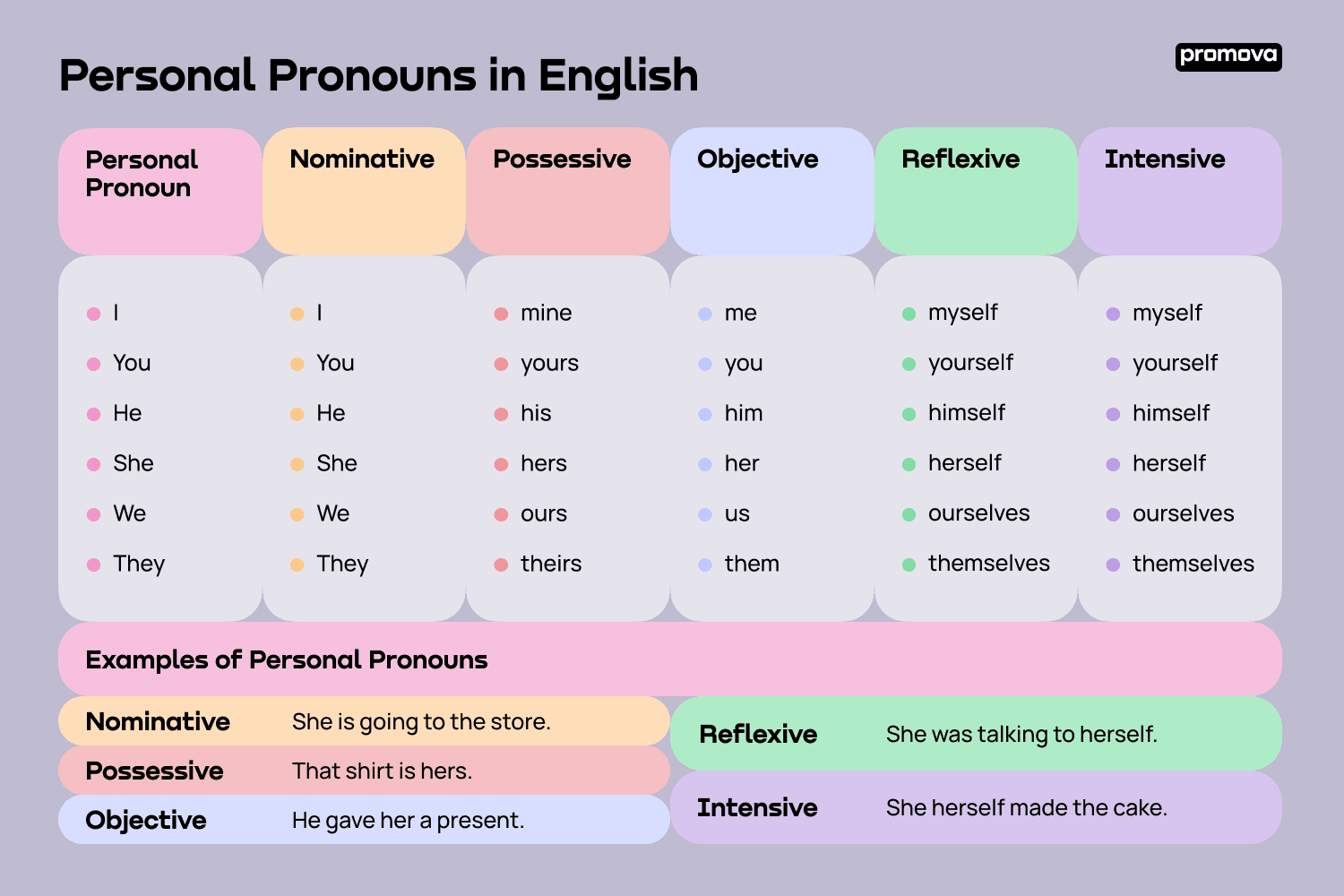Personal Pronouns in English
Contents
Personal pronouns are words like “he,” “she” “it,” “they,” and “we.” They help us replace nouns and make sentences easier to read and understand. In this reference, we'll discuss the basics of personal pronouns in English grammar, including the types of pronouns, examples of pronouns, and how to correctly use them in a sentence.
What are Personal Pronouns?
Personal pronouns help us replace a noun. They are used to make sentences shorter and easier to read.
For example, instead of saying “The dog is running,” you could say “It is running.” This is much easier to say and understand. Personal pronouns can also be used to refer to people, such as “he.” “she,” “they,” and “we.”
In English grammar, personal pronouns are used to show the person or thing being spoken about.
For example, if you are talking about someone, you would use “he,” “she,” or “they.” If you are talking about an object, you would use “it.”
Another important aspect of personal pronouns is the gender of the person or thing being referred to. In English, you can use either masculine (he, him, his) or feminine (she, her, hers) pronouns to refer to people. For objects, you would use “it.”

Types of Personal Pronouns
There are three types of personal pronouns: subjective, objective, and possessive.
- The subjective personal pronouns are “I,” “you,” “she,” “he,” “it,” “we,” and “they.” We use them when the speaker is the subject of the sentence. For example, “I am eating dinner.”
- The objective personal pronouns are “me,” “you,” “her,” “him,” “it,” “us,” and “them.” We use them speaker is the object of the sentence. For example, “He gave me a gift.”
- The possessive personal pronouns are “mine,” “yours,” “hers,” “his,” “its,” “ours,” and “theirs.” These pronouns are used to show possession or ownership. For example, “The book is mine.”
2
Personal Pronouns in English Grammar
In English grammar, personal pronouns can be used in different cases. The five cases are nominative, possessive, objective, reflexive, and intensive.
- We use the nominative case when our pronoun is the subject of the sentence. For example, “She is eating dinner.”
- The possessive case is used when the pronoun is used to show possession or ownership. For example, “The book is hers.”
- The objective case is used when our pronoun is the object of the sentence. For example, “He gave her the gift.”
- The reflexive case is used when the pronoun is used to refer back to the subject. For example, “She gave herself a gift.”
- The intensive case is used when the pronoun is used to emphasize or add emphasis to the subject. For example, “She herself made the cake.”
Personal Pronouns Chart
To help you remember this reference, here is a handy chart of the personal pronouns and their cases.
| Personal Pronoun | Nominative | Possessive | Objective | Reflexive | Intensive |
| I | I | mine | me | myself | myself |
| You | You | yours | you | yourself | yourself |
| He | He | his | him | himself | himself |
| She | She | hers | her | herself | herself |
| We | We | ours | us | ourselves | ourselves |
| They | They | theirs | them | themselves | themselves |
Examples of Personal Pronouns
Now that you know personal pronouns and their cases let’s look at some examples.
- Nominative: She is going to the store.
- Possessive: That shirt is hers.
- Objective: He gave her a present.
- Reflexive: She was talking to herself.
- Intensive: She herself made the cake.
Personal Pronouns List
Here is a simple cheat sheet for you to remember personal pronouns:
- I
- You
- He
- She
- It
- We
- They
Personal Pronouns in Different Numbers
In English, personal pronouns can also be used to refer to people in different numbers. For example, you can use the singular pronouns “I,” “you,” “he,” “she,” and “it” to refer to one person or thing and the plural pronouns “we” and “they” to refer to more than one person or thing.
Examples of personal pronouns in different numbers.
- Singular: She is going to the store.
- Plural: They were talking to each other.
Using Personal Pronouns in a Sentence
Let’s look at how to correctly use these pronouns.
Identify the subject of the sentence.
Your subject is the person or thing performing the action. If the subject is a person, you should use the appropriate pronoun depending on the gender (male or female) and number (singular or plural).
Use the correct pronoun in the correct case.
For example, if the subject is “she” and the pronoun is the subject in your sentence, you should use the nominative case (she). If your pronoun is the object of the sentence, you should use the objective case (her).
Summary
Personal pronouns are useful to know so that you can accurately refer to people in a sentence. There are different types of personal pronouns depending on gender, number, and case. For example, there are singular and plural pronouns, as well as nominative, possessive, objective, reflexive, and intensive pronouns.
Now that you've learned everything about them try using pronouns in your English to practice and improve!



Comments